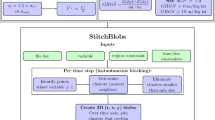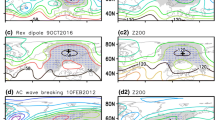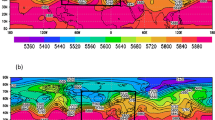Abstract
This paper aims to provide a new blocking definition with applicability to observations and model simulations. An updated review of previous blocking detection indices is provided and some of their implications and caveats discussed. A novel blocking index is proposed by reconciling two traditional approaches based on anomaly and absolute flows. Blocks are considered from a complementary perspective as a signature in the anomalous height field capable of reversing the meridional jet-based height gradient in the total flow. The method succeeds in identifying 2-D persistent anomalies associated to a weather regime in the total flow with blockage of the westerlies. The new index accounts for the duration, intensity, extension, propagation, and spatial structure of a blocking event. In spite of its increased complexity, the detection efficiency of the method is improved without hampering the computational time. Furthermore, some misleading identification problems and artificial assumptions resulting from previous single blocking indices are avoided with the new approach. The characteristics of blocking for 40 years of reanalysis (1950–1989) over the Northern Hemisphere are described from the perspective of the new definition and compared to those resulting from two standard blocking indices and different critical thresholds. As compared to single approaches, the novel index shows a better agreement with reported proxies of blocking activity, namely climatological regions of simultaneous wave amplification and maximum band-pass filtered height standard deviation. An additional asset of the method is its adaptability to different data sets. As critical thresholds are specific of the data set employed, the method is useful for observations and model simulations of different resolutions, temporal lengths and time variant basic states, optimizing its value as a tool for model validation. Special attention has been paid on the devise of an objective scheme easily applicable to General Circulation Models where observational thresholds may be unsuitable due to the presence of model bias. Part II of this study deals with a specific implementation of this novel method to simulations of the ECHO-G global climate model.










Similar content being viewed by others
References
Austin JF (1980) The blocking of middle latitude westerly winds by planetary waves. Q J R Meteorol Soc 106:327–350
Barriopedro D, Garcia-Herrera R, Lupo AR, Hernández E (2006) A climatology of Northern Hemisphere blocking. J Clim 19:1042–1063
Barriopedro D, García-Herrera R, Huth R (2008) Solar modulation of Northern Hemisphere winter blocking. J Geophys Res 113:D14118. doi:10.1029/2008JD009789
Carrera ML, Higgins RW, Kousky VE (2004) Downstream weather impacts associated with atmospheric blocking over the northeast Pacific. J Clim 17:4823–4839
Cash BA, Lee S (2000) Dynamical processes of block evolution. J Atmos Sci 57:3202–3218
Charney JG, DeVore JG (1979) Multiple flow equilibria in the atmosphere and blocking. J Atmos Sci 36:1205–1216
Charney JG, Shukla J, Mo KC (1981) Comparison of a barotropic blocking theory with observation. J Atmos Sci 38:762–779
Chen T-C, Yoon JH (2002) Interdecadal variation of the North Pacific wintertime blocking. Mon Weather Rev 130:3136–3143
Croci-Maspoli M, Schwierz C, Davies HC (2007) Atmospheric blocking: space-time links to the NAO and PNA. Clim Dyn 29:713–725
D’Andrea F et al (1998) Northern Hemisphere atmospheric blocking as simulated by 15 atmospheric general circulation models in the period 1979–1988. Clim Dyn 14:385–407
Diao Y, Li J, Luo D (2006) A new blocking index and its application: blocking action in the northern hemisphere. J Clim 19:4819–4839
Doblas-Reyes FJ, Casado MJ, Pastor MA (2002) Sensitivity of the Northern Hemisphere blocking frequency to the detection index. J Geophys Res 107. doi:10.1029/2000JD000290
Dole RM, Gordon ND (1983) Persistent anomalies of the extra-tropical northern hemisphere wintertime circulation: geographical distribution and regional persistence characteristics. Mon Weather Rev 111:1567–1586
Elliot RD, Smith TB (1949) A study of the effect of large blocking highs on the general circulation in the northern hemisphere westerlies. J Meteor 6:67–85
García-Herrera R, Barriopedro D (2006) Northern hemisphere snow cover and atmospheric blocking variability. J Geophys Res 111:D21104. doi:10.1029/2005JD006975
García-Herrera R, Paredes D, Trigo RM, Trigo IF, Hernández E, Barriopedro D, Mendes MA (2007) The outstanding 2004–2005 drought in the Iberian Peninsula: impacts and atmospheric circulation associated. J Hydrometeor 8:469–482
Hartmann DL, Ghan SJ (1980) A statistical study of the dynamics of blocking. Mon Weather Rev 108:1144–1159
Huang F, Zhou FX, Qian XD (2002) Interannual and decadal variability of North Pacific blocking and its relationship to SST, teleconnections and storm track. Adv Atmos Sci 19:807–820
Kaas E, Branstator G (1993) The relationship between a zonal index and blocking activity. J Atmos Sci 50:3061–3077
Kalnay E et al (1996) The NCEP/NCAR 40-years reanalyses project. Bull Am Meteor Soc 77:437–471
Knox JL, Hay JE (1984) Blocking signatures in the northern hemisphere: rationale and identification. Atmos Ocean 22:36–47
Knox JL, Hay JE (1985) Blocking signatures in the northern hemisphere: frequency distribution and interpretation. J Clim 5:1–16
Lejenäs H, Økland H (1983) Characteristics of northern hemisphere blocking as determined from long time series of observational data. Tellus 35A:350–362
Liu Q (1994) On the definition and persistence of blocking. Tellus 46A:286–290
Luo D, Wan H (2005) Decadal variability of wintertime North Atlantic and Pacific blockings: a possible cause. Geophys Res Lett 32:L23810. doi:10.1029/2005GL024329
Lupo AR, Smith PJ (1995) Climatological features of blocking anticyclones in the Northern Hemisphere. Tellus 47A:439–456
Masato M, Hoskins BJ, Woollings TJ (2009) Can the frequency of blocking be described by a red noise process? J Atmos Sci 66:2143–2149. doi:10.1175/2008JAS2907.1
Metz W (1986) Transient cyclone-scale vorticity forcing of blocking highs. J Atmos Sci 43:1467–1483
Michelangeli P, Vautard R, Legras B (1995) Weather regime occurrence and quasi stationarity. J Atmos Sci 52:1237–1256
Mullen SL (1986) The local balances of vorticity and heat for blocking anticyclones in a spectral General Circulation Model. J Atmos Sci 43:1406–1441
Mullen SL (1989) Model experiments on the impact of Pacific sea surface temperature anomalies on blocking frequency. J Clim 2:997–1013
Nakamura H, Nakamura M, Anderson JL (1997) The role of high and low frequency dynamics and blocking formation. Mon Weather Rev 125:2074–2093
Namias J (1950) The index cycle and its role in the general circulation. J Meteor 7:130–139
Pelly J, Hoskins B (2003) A new perspective on blocking. J Atmos Sci 60:743–755
Quiroz RS (1984) The climate of 1983–84 winter. A season of strong blocking and severe cold in North America. Mon Weather Rev 112:1894–1912
Rex DF (1950a) Blocking action in the middle troposphere and its effect upon regional climate. Part I: An aerological study of blocking action. Tellus 2:196–211
Rex DF (1950b) Blocking action in the middle troposphere and its effect upon regional climate. Part II: The climatology of blocking action. Tellus 2:275–301
Rex DF (1951) The effect of Atlantic blocking action upon European climate. Tellus 3:1–16
Rossby CG (1939) Relation between the variations in the intensity of the zonal circulation of the atmosphere on the displacement of the semi-permanent centers of action. J Mar Res 2:38–55
Sanders RA (1953) Blocking highs over the eastern North Atlantic ocean and western Europe. Mon Weather Rev 81:67–73
Sausen R, König W, Sielmann F (1995) Analysis of blocking events observation and ECHAM model simulations. Tellus 47A:421–438
Scherrer SC, Croci-Maspoli M, Schwierz C, Appenzeller C (2006) Two-dimensional indices of atmospheric blocking and their statistical relationship with winter climate patterns in the euro-atlantic region. Int J Climatol 26:233–249
Schwierz C, Croci-Maspoli M, Davies HC (2004) Perspicacious indicators of atmospheric blocking. Geophys Res Lett 31:6125–6128
Schwierz C, Appenzeller C, Davies HC, Liniger MA, Muller W, Stocker TF, Yoshimori M (2006) Challenges posed by and approaches to the study of seasonal-to-decadal climate variability. Clim Change 79:31–63
Shukla J, Mo KC (1983) Seasonal and geographical variation of blocking. Mon Weather Rev 111:388–402
Stan C, Straus DM (2007) Is blocking a circulation regime? Mon Weather Rev 135:2406–2413
Sumner EJ (1954) A study of blocking in the Atlantic-European sector of the Northern Hemisphere. Q J R Meteorol Soc 80:402–416
Tibaldi S, Molteni F (1990) On the operational predictability of blocking. Tellus 42A:343–365
Tibaldi S, Tosi E, Navarra A, Pedulli L (1994) Northern and Southern hemisphere seasonal variability of blocking frequency and predictability. Mon Weather Rev 122:1971–2003
Treidl RA, Birch EC, Sajecki P (1981) Blocking action in the Northern Hemisphere: a climatological study. Atmos Ocean 19:1–23
Trenberth KE et al (2007) Observations: surface and atmospheric climate change. In: Solomon S, Qin D, Manning M, Chen Z, Marquis M, Averyt KB, Tignor M, Miller HL et al (eds) Climate change 2007: the physical science basis. Contribution of Working Group I to the Fourth Assessment Report of the Intergovernmental Panel on Climate Change. Cambridge University Press, Cambridge
Trigo RM, Trigo IF, DaCamara CC, Osborn TJ (2004) Winter blocking episodes in the European-Atlantic sector: climate impacts and associated physical mechanisms in the reanalysis. Clim Dyn 23:17–28
Tsou CH, Smith PJ (1990) The role of synoptic/planetary-scale interactions during the development of a blocking anticyclone. Tellus 42A:174–193
Tyrlis R, Hoskins BJ (2008) Aspects of Northern Hemisphere atmospheric blocking climatology. J Atmos Sci 65:1638–1652
Vautard R (1990) Multiple weather regimes over the North Atlantic: analysis of precursors and successors. Mon Weather Rev 118:2056–2081
Verdecchia M, Visconti G, D’Andrea F, Tibaldi S (1996) A neural network approach for blocking recognition. Geophys Res Lett 23:2081–2084
Wang L, Chen W, Zhou W, Chan JCL, Barriopedro D, Huang R (2009) Effect of the climate shift around mid 1970’s on the relationship between wintertime Ural blocking circulation and East Asian climate. Int J Climatol. doi:10.1002/joc.1876
Wiedenmann JM, Lupo AR, Mokhov II, Tikhonova EA (2002) The climatology of blocking anticyclones for the Northern and Southern Hemispheres: block intensity as a diagnostic. J Clim 15:3459–3473
Acknowledgments
This study received support from MICINN through the TRODIM (CGL2007-65891-C05-05/CLI and CGL2007-65891-C05-02/CLI) projects, from IDL-FCUL through the ENAC (PTDC/AAC-CLI/103567/2008) project and from the EU 6th Framework Program (CIRCE) contract number 036961 (GOCE). We would like to thank J. F. González-Rouco for providing useful comments and suggestions. Two anonymous reviewers contributed to improve the final version of this paper.
Author information
Authors and Affiliations
Corresponding author
Appendix: Computation of the anomaly field
Appendix: Computation of the anomaly field
Assuming that the length of the data set is K years, N the number of data points per year and M the number of data points per month so that 1 ≤ t ≤ K N and 1 ≤ τ ≤ N, a four-step procedure has been applied: (1) evaluation of a running annual mean with special treatment of the ends of the time series (Eq. 5); (2) determination of a running monthly mean of the anomaly relative to the annual mean (Eq. 6); (3) computation of the mean seasonal cycle (Eq. 7); (4) computation of the anomaly field by extracting the annual mean and the seasonal cycle from the total flow (Eq. 8).
Rights and permissions
About this article
Cite this article
Barriopedro, D., García-Herrera, R. & Trigo, R.M. Application of blocking diagnosis methods to General Circulation Models. Part I: a novel detection scheme. Clim Dyn 35, 1373–1391 (2010). https://doi.org/10.1007/s00382-010-0767-5
Received:
Accepted:
Published:
Issue Date:
DOI: https://doi.org/10.1007/s00382-010-0767-5




